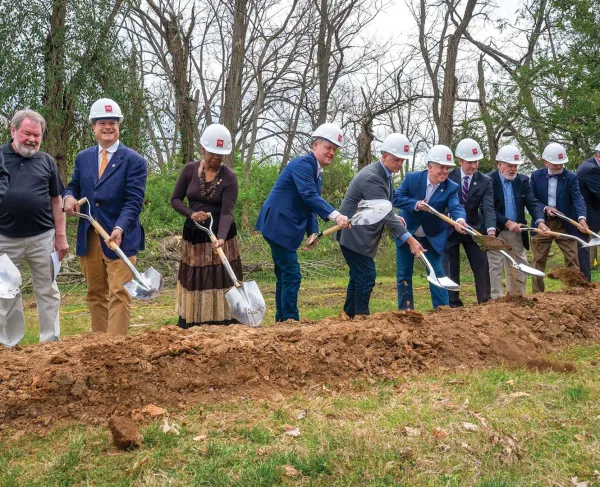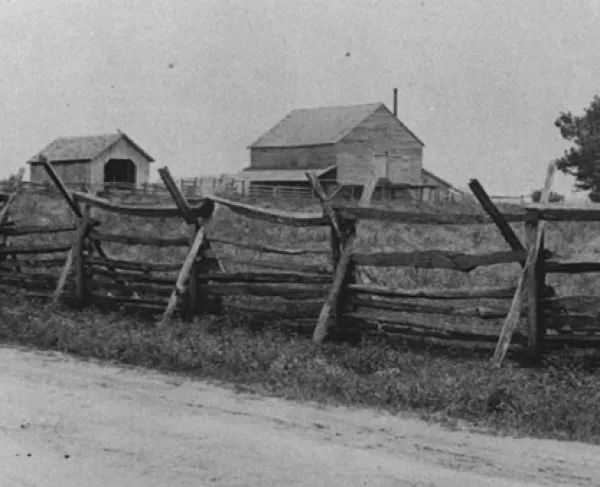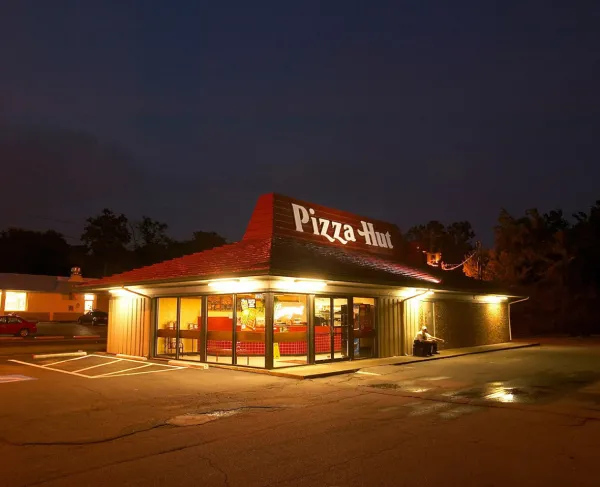Franklin
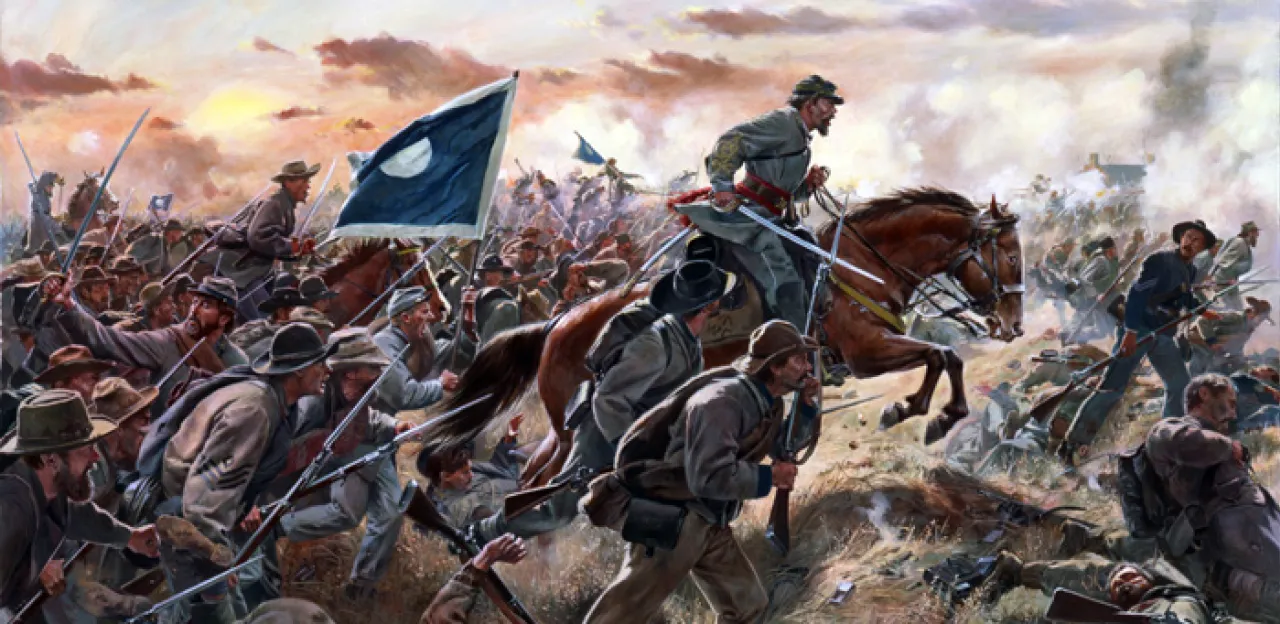
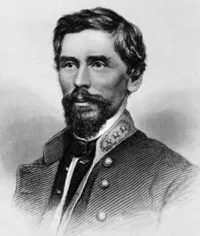
Major General Patrick Ronayne Cleburne was angry on the march from Spring Hill, Tennessee, toward the small town of Franklin in the late morning hours of November 30, 1864. After the campaign he was going to demand a full investigation to defend his conduct on November 29 at Spring Hill where the Federals slipped past the Southern forces. General Cleburne had been given information from a “reliable channel” that he was being blamed by General John Bell Hood for the Confederate failure the day before.
Around 2:30 p.m., nearing Franklin, General Cleburne rode up on Winstead Hill after the Federals had withdrawn from it and Breezy Hill. He rested field glasses on a tree stump and, looking toward the Federal lines, he remarked, “They are formidable.” A courier from Hood informed General Cleburne that his presence was required for a conference at the home of William Harrison, which stood approximately one-half mile south of Winstead Hill. Hood told his commanders his plans for a frontal assault against the Federal works and asked for opinions. Major Generals Nathan B. Forrest, B. Franklin Cheatham, and Cleburne all advised against an attack over open fields against entrenchments and artillery.
As General Cleburne mounted his horse to return to his division, Hood ordered:
General, form your division to the right of the pike, letting your left overlap the same. General Brown will form on the left with his right overlapping your left. I wish you to move on the enemy. Give orders to your men not to fire a gun until you run the Yankee skirmish line from behind the first line of works in your front, then press them and shoot them in their backs as they run to their main line; then charge the enemy works. Franklin is the key to Nashville and Nashville is the key to independence.
Cleburne replied, “General, I will take the works or fall in the attempt.”
Before the fateful Battle of Franklin, General Cleburne held his last meeting with his brigade commanders on Breezy Hill. Brigadier General Daniel C. Govan felt that General Cleburne was “greatly depressed.” General Cleburne emphasized Hood’s orders that the Federal works must be carried by the point of the bayonet at all hazards. Govan saluted and said, “Well, General, few of us will ever return to Arkansas to tell the story of this battle.” Cleburne replied with a sentiment that was prevalent in most of the hearts of the men in the gallant Army of Tennessee: “Well, Govan, if we are to die, let us die like men.”
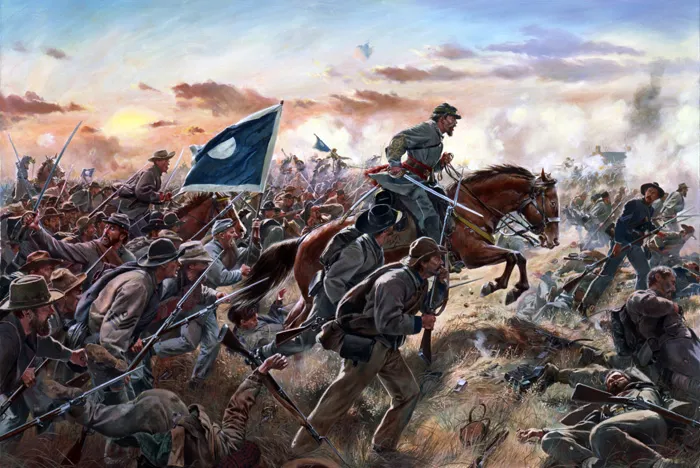
General Cleburne received permission to form his division in columns of brigades to expose as small a front as possible and then to deploy into line of battle when in range of small arms fire without confusion.
Cleburne’s Division was made up of Texans in Brigadier General Hiram B. Granbury’s Brigade whom General Cleburne called “a band of heroes.” Tough Arkansans in Govan’s Brigade and gallant Alabamians and Mississippians in Brigadier General Mark P. Lowrey’s Brigade also were in the ranks. The 5th Confederate Infantry Regiment, nearly all Irish and very close to Cleburne, filled out the division.
The Federal main defense line was crescent-shaped, with the center located around the brick home owned by Fountain Branch Carter. In many areas the works were six- to eight-feet high with wide ditches on both sides. Planks from the Carters’ gin house, barn, other outbuildings, and even eight plows were used in the construction of the breastworks. Part of the entrenchments had been constructed in 1863 and needed only slight improvement. The breastworks began near the Lewisburg Pike and continued onto the Columbia Pike, then westward past Carter’s Creek Pike, ending near the northwest side of town. A thorny osage orange grove grew in the Lewisburg Pike area; the Federal soldiers sharpened branches of the osage orange trees and carried them across the pike to form an almost impassable obstruction. In the center of the line, the Carter house and cotton gin house were situated on a small hill. A retrenched line was placed fifty yards behind the main line. About 250 yards southwest of the Carter house was a locust grove, which served as an obstruction to any attacking force. Fort Granger, located north of the Harpeth River, had artillery batteries placed inside to cover the southeast. Another less formidable Federal line was approximately one-half mile south of the main line.
General Frank Cheatham’s Corps would assault the center of the Federal works, with Major General John C. Brown’s Division on the west side of the Columbia Pike and Cleburne’s Division on the east side. Major General William B. Bate’s Division would attack to the left of Brown’s Division. Lieutenant General Alexander P. Stewart’s Corps would assault on the right with Major Generals William Loring, Edward Walthall, and Samuel French’s Divisions. Lieutenant General Stephen D. Lee’s Corps, coming from Spring Hill, had not yet arrived on the field. It was planned that General Nathan Bedford Forrest would attempt to flank the Federals on the east and west.
Cleburne’s Division would move forward with approximately 3,000 men. Granbury’s and Govan’s Brigades were in front with Lowrey’s Brigade in reserve. Colonel A.J. Smith’s Georgia Brigade was not on the field.
General Cheatham later stated of final tense moments:
Before moving our troops from Winstead Hill I had arranged with both Cleburne and Brown, the two divisions under my eye to give them the word with a flag when to move. When their lines swung into position they corrected their alignment and then faced toward me, waiting for the signal to advance. A moment of suspense to see that everything was ready, then the flag dropped, and the line moved forward as steady as a clock.
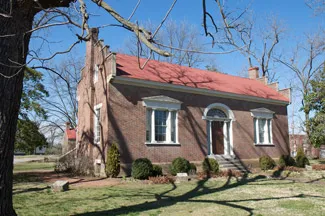
It was a beautiful Indian summer afternoon with a temperature around 45 degrees. The air was perfectly still, and the skyline was a crimson red. At 4 p.m., as the sun was setting in the southwest, the crescent moon rose in the southeast, and 20,000 Confederates, eighteen brigades, and over 100 infantry regiments marched down the slopes and into immortality. Bands started to play. The blue flag with the white moon of Cleburne’s Division was conspicuous among the red St. Andrew’s cross battle flags.
Lieutenant W.D. Mintz, 5th Arkansas Infantry, remembered the fateful charge:
We had gone but little ways when the artillery opened fire on us, which had but little effect on the line save when a bursting shell would tear its way through the ranks, the men would soon close in and make the line solid again...
The Federal brigades of Colonel Joseph Conrad and Colonel John Lane in Brigadier General George D. Wagner’s Division held the advanced line. Wagner’s orders were to fall back if there was a frontal assault. Wagner disobeyed orders, telling a staff officer, “Stand there and fight them.” Granbury’s hard-hitting Texans were the first to break the center of this advanced Federal line. A memory of this horrific event was later recorded by Private William Eldridge Mathews Preston of the 33rd Alabama:
The ground was open, shells exploding within about one thousand yards of their works and after they had opened on us with small arms the command “double-quick” was given. Then we went on a run and a continuous yell to their works... I was wounded in getting through the abatis, by the time we got to their works out ranks were so thinned that our men could not get over. Many were shot in the attempt...
General Hiram B. Granbury was on foot, encouraging his Texans with his last immortal words: “Forward, men; never let it be said that Texans lag in the fight.” A minié ball then hit him in his cheek and passed through the back of his head. Granbury was found on his knees with his hands on his face the next morning, dead.
Cleburne was riding a brown mare that belonged to Lieutenant Tip Stanton, a member of his escort. The horse was killed about eighty yards from the works. James Brandon, a courier from Mississippi, dismounted to give the general his horse. The animal was killed before General Cleburne could place himself in the saddle. Cleburne moved forward into the smoke, sword in hand, waving his kepi and encouraging his men. Around fifty yards from the Federal works in front of the cotton gin house, a minié ball struck him just below the heart and passed through his body. Captain C.W. Frazer of the 5th Confederate would later write:
He [General Cleburne] sought out our regiment, charged in with it, and died with it. He could have selected no better place.
John McQuaide would later give to the Vicksburg Herald his account of finding General Cleburne’s body:
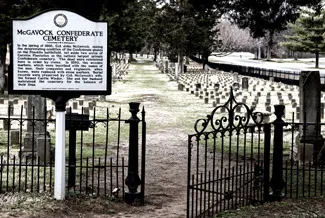
"The terrible report that Cleburne was missing ran throughout our ranks that whole dreadful night... I and two others were the first to discover his dead body at early dawn, the next morning. He was about 40 or 50 yards from the works. He lay flat upon his back, as if to sleep, with his military cap partly over his eyes. He had on a new gray uniform, the coat of the sack or blouse pattern. It was unbuttoned and open; the lower part of his vest was unbuttoned. He wore a white linen shirt which was stained with blood on the front part of the left side, or just off the abdomen... He was in his sock feet, his boots having been stolen. His watch, dress sword, belt and other valuables were all gone; his body having been robbed during the night..."
McQuaide found an ambulance in the charge of Rev. Thomas Markham, Chaplain of Brigadier General Winfield Scott Featherston’s Mississippi Brigade. The men with the reverend were lifting the body of Brigadier General John Adams into a wagon. McQuaide guided the men to General Cleburne’s body and assisted in placing him in the same wagon.
During the aftermath, every building in Franklin was used as a hospital. The bodies of General Cleburne and General John Adams were brought to Carnton, the home of John McGavock, which stood approximately one-and-a-quarter miles to the east. General Cleburne was placed on the porch next to Generals Adams and Granbury, Brigadier General Otho French Strahl, Lieutenant Colonel R.B. Young, and Lieutenant John Marsh.
In 1883, General Frank Cheatham returned to Franklin for the first time since the battle and stated of General Cleburne: “Here one of the best soldiers that ever drew sword gave up his life.”
Thomas Y. Cartwright is the Director of the historic Carter House in Franklin, Tennessee.
